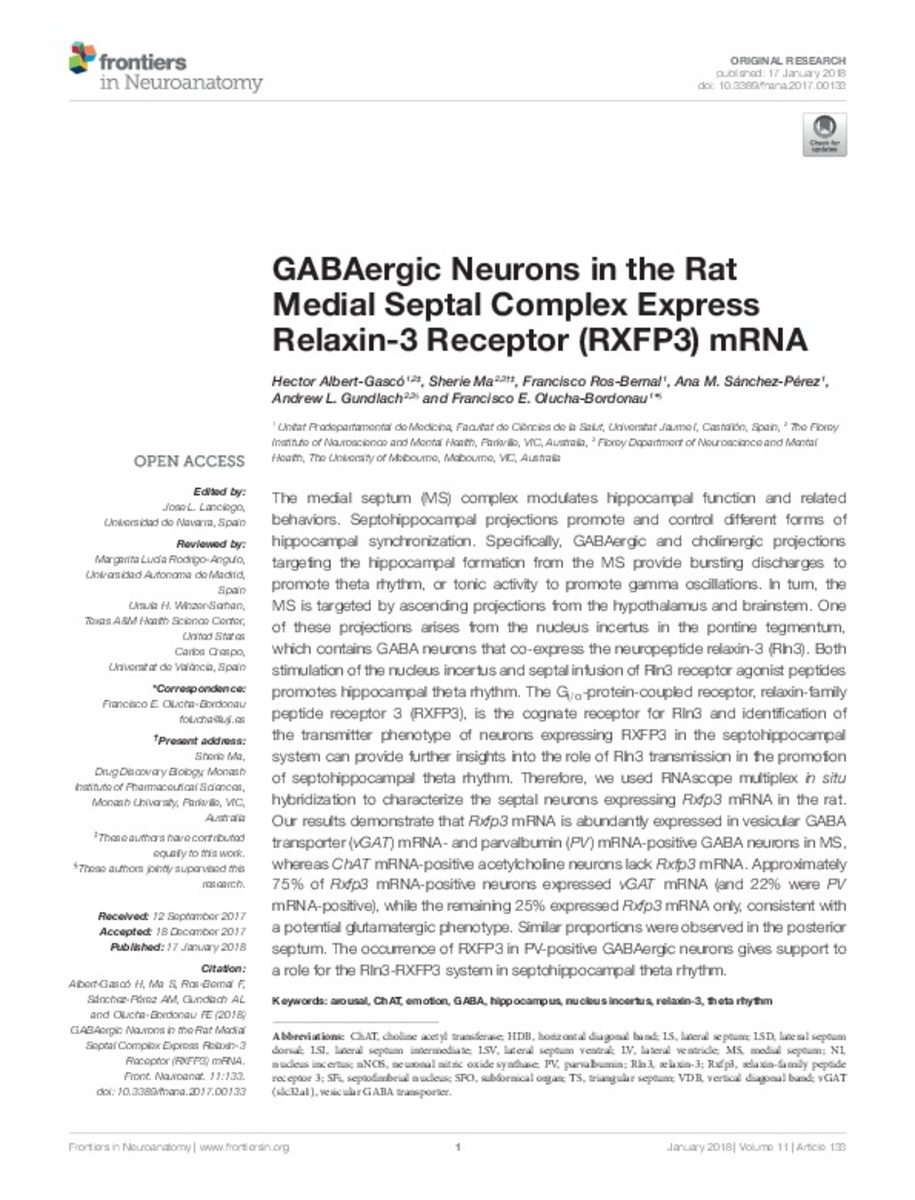Mostrar el registro sencillo del ítem
GABAergic Neurons in the Rat Medial Septal Complex Express Relaxin-3 Receptor (RXFP3) mRNA
| dc.contributor.author | Albert Gasco, Hector | |
| dc.contributor.author | Ma, Sherie | |
| dc.contributor.author | Ros Bernal, Francisco | |
| dc.contributor.author | Sánchez-Pérez, Ana María | |
| dc.contributor.author | Gundlach, Andrew Lawrence | |
| dc.contributor.author | Olucha-Bordonau, Francisco E | |
| dc.date.accessioned | 2018-03-13T11:00:14Z | |
| dc.date.available | 2018-03-13T11:00:14Z | |
| dc.date.issued | 2018-01-17 | |
| dc.identifier.citation | ALBERT GASCÓ, Héctor; MA, Sherie; ROS BERNAL, Francisco; SÁNCHEZ-PÉREZ, Ana María; GUNDLACH, Andrew L.; OLUCHA BORDONAU, Francisco E. GABAergic Neurons in the Rat Medial Septal Complex Express Relaxin-3 Receptor (RXFP3) mRNA. Frontiers in Neuroanatomy (2018), v. 11 | ca_CA |
| dc.identifier.uri | http://hdl.handle.net/10234/173328 | |
| dc.description.abstract | The medial septum (MS) complex modulates hippocampal function and related behaviors. Septohippocampal projections promote and control different forms of hippocampal synchronization. Specifically, GABAergic and cholinergic projections targeting the hippocampal formation from the MS provide bursting discharges to promote theta rhythm, or tonic activity to promote gamma oscillations. In turn, the MS is targeted by ascending projections from the hypothalamus and brainstem. One of these projections arises from the nucleus incertus in the pontine tegmentum, which contains GABA neurons that co-express the neuropeptide relaxin-3 (Rln3). Both stimulation of the nucleus incertus and septal infusion of Rln3 receptor agonist peptides promotes hippocampal theta rhythm. The Gi=o-protein-coupled receptor, relaxin-family peptide receptor 3 (RXFP3), is the cognate receptor for Rln3 and identification of the transmitter phenotype of neurons expressing RXFP3 in the septohippocampal system can provide further insights into the role of Rln3 transmission in the promotion of septohippocampal theta rhythm. Therefore, we used RNAscope multiplex in situ hybridization to characterize the septal neurons expressing Rxfp3 mRNA in the rat. Our results demonstrate that Rxfp3 mRNA is abundantly expressed in vesicular GABA transporter (vGAT) mRNA- and parvalbumin (PV) mRNA-positive GABA neurons in MS, whereas ChAT mRNA-positive acetylcholine neurons lack Rxfp3 mRNA. Approximately 75% of Rxfp3 mRNA-positive neurons expressed vGAT mRNA (and 22% were PV mRNA-positive), while the remaining 25% expressed Rxfp3 mRNA only, consistent with a potential glutamatergic phenotype. Similar proportions were observed in the posterior septum. The occurrence of RXFP3 in PV-positive GABAergic neurons gives support to a role for the Rln3-RXFP3 system in septohippocampal theta rhythm. | ca_CA |
| dc.format.extent | 16 p. | ca_CA |
| dc.format.mimetype | application/pdf | ca_CA |
| dc.language.iso | eng | ca_CA |
| dc.publisher | Frontiers Media | ca_CA |
| dc.relation.isPartOf | Frontiers in Plant Science (2018), v. 11 | ca_CA |
| dc.rights | Atribución 4.0 Internacional | * |
| dc.rights.uri | http://creativecommons.org/licenses/by-sa/4.0/ | * |
| dc.subject | Arousal | ca_CA |
| dc.subject | ChAT | ca_CA |
| dc.subject | Emotion | ca_CA |
| dc.subject | GABA | ca_CA |
| dc.subject | Hippocampus | ca_CA |
| dc.subject | Nucleus incertus | ca_CA |
| dc.subject | Relaxin-3 | ca_CA |
| dc.subject | Theta rhythm | ca_CA |
| dc.title | GABAergic Neurons in the Rat Medial Septal Complex Express Relaxin-3 Receptor (RXFP3) mRNA | ca_CA |
| dc.type | info:eu-repo/semantics/article | ca_CA |
| dc.identifier.doi | http://dx.doi.org/10.3389/fnana.2017.00133 | |
| dc.rights.accessRights | info:eu-repo/semantics/openAccess | ca_CA |
| dc.relation.publisherVersion | https://www.frontiersin.org/articles/10.3389/fnana.2017.00133/full | ca_CA |
| dc.contributor.funder | 1) Universitat Jaume I FPI-UJI Predoctoral Research Scholarship PREDOC/2014/35 (HA-G); 2) E-2016-43 Research Travel Grant (HA-G); 3) NHMRC (Australia) Project Grant 1067522 (ALG); 4) Dorothy Levien Foundation Research Grant (ALG); and 5) Universitat Jaume I Research Grant UJI-B2016-40 (FEO-B). | ca_CA |
| dc.type.version | info:eu-repo/semantics/publishedVersion | ca_CA |
Ficheros en el ítem
Este ítem aparece en la(s) siguiente(s) colección(ones)
-
MED_Articles [636]
Articles de publicacions periòdiques








